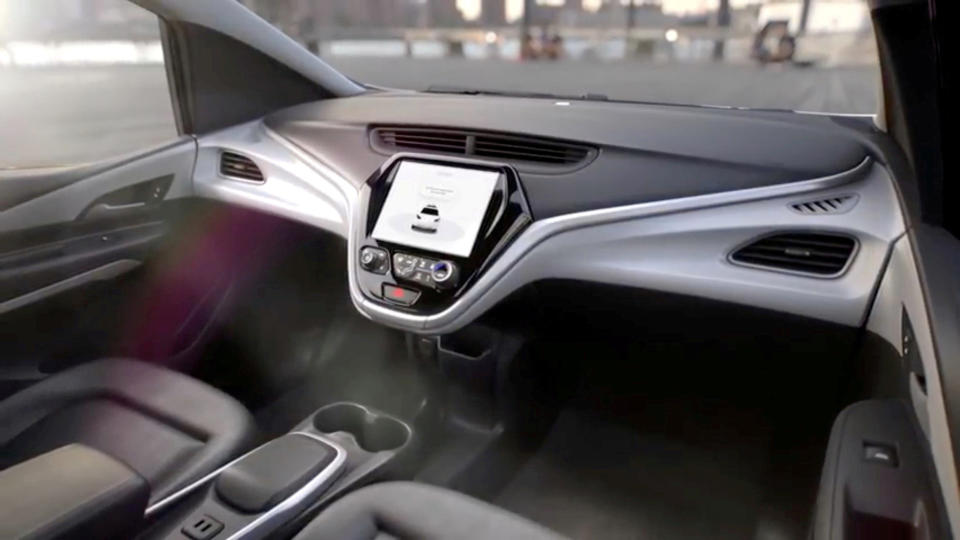GM’s self-driving-car project will have Honda riding shotgun
The self-driving-car subsidiary of General Motors (GM) is getting help from one of its parent firm’s chief rivals.
San Francisco-based Cruise Automation announced Wednesday morning that Honda Motor Corp. (HMC) will help build its next autonomous vehicle and kick in about $2 billion over the next dozen years towards that project, plus an equity investment of $750 million.
“It marks another step in our journey towards a world with zero crashes, zero emissions and zero congestion,” GM chairman and CEO Mary Barra said during a press call.
Honda executive vice president and representative director chief operating officer Seiji Kuraishi added: “We are passionate about providing sustainable mobility products.”
The product of this joint venture will represent Cruise’s second self-driving car — its first, based on GM’s Chevy Bolt electric car, is already in tests with a rollout still planned for 2019.
Executives on the call declined to get into any details about when the fruit of this collaboration would begin rolling off assembly lines and where those assembly lines might be.

Michelle Krebs, executive analyst with Autotrader, wrote in an e-mail that this move represented “a significant milestone in moving self-driving closer to reality.”
In a Medium.com post, Cruise CEO Kyle Vogt noted that it usually takes four years and a billion dollars to bring a new vehicle to market. “It’s our intent to move as quickly as possible,” he told Yahoo Finance in an interview after the call.
Vogt’s post shows a black-and-white photograph of the front of a streamlined vehicle that looks a lot like a wheeled version of one of Star Trek’s shuttlecraft.
“I think it’s fair to say that this vehicle will look distinct from most cars that are on the road today,” Vogt said.
“Shouldn’t the car of the future have giant TV screens, a mini bar, and lay-flat seats? Maybe it should,” he wrote in that post. “We’ve been quietly prototyping a ground-breaking new vehicle over the past two years that is fully released from the constraints of having a driver behind the wheel.”
This won’t be a car you can buy, however. As with its Bolt-based car, Cruise plans to make this one available as a service. “Ride-sharing customers and potentially other customers would use this as a fleet model,” he said. “That’s the right way to bring this to market.”
This is not the first time Cruise, which GM bought in 2016, has opted to bring in outside expertise. It hired security experts Charlie Miller and Chris Valasek—the duo who remotely hacked a Jeep Cherokee in 2015—to secure its vehicles, with the fleet model’s centralized control of software updates a big part of that.
It’s also not GM’s first collaboration with Honda: The two launched a partnership in January 2017 partnership to produce fuel cells, which Honda sees as a way to replace gas engines without the long recharging times of battery-electric vehicles.
Analysts noted the importance of collaboration to the future of the auto industry. Wrote Krebs: “Global partnerships like these – Detroit, Silicon Valley and Japan – are necessary to take on these expensive ventures that likely will not return a profit in the near-term.”
Cruise faces competition from numerous rivals, including many based far from Detroit, Tokyo or Stuttgart. The first firm to sell rides to Americans looks to be the Waymo self-driving-car subsidiary of Google’s parent Alphabet, Inc. (GOOG, GOOGL).
Honda had been discussing a collaboration with Waymo, but during the call Kuraishi said (in Japanese via an interpreter) said that was over. “We decided to have an exclusive collaboration with GM and Cruise in the field.”
Tesla (TSLA) may be reeling from the Securities and Exchange Commission’s $20 million fine on founder Elon Musk for tweeting out a vaporous plan to take the firm private. But it would be a mistake to count out the firm building electric, semi-autonomous cars in the factory left over from an earlier GM joint venture with a Japanese automaker—its doomed 1980s collaboration with Toyota.
Overseas, GM and Honda’s venture will face competition from ambitious and well-funded efforts by Chinese automakers.
In the interview, Vogt acknowledged the importance—subject to keeping Cruise’s cars safe—of bringing this next vehicle to roads as soon and in as many numbers as possible.
“The whole point of getting two very successful OEMs to collaborate enables that path to scale,” he said. “Having hand-built dozens of autonomous vehicle prototypes tin the past, I can say that’s not how you get to scale.”
Email Rob at rob@robpegoraro.com; follow him on Twitter at @robpegoraro.

 Yahoo Finance
Yahoo Finance 
